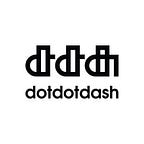Lidar Scanning For Environments
A dotdotdash Lab Report
Question
Whether it be an installation, pop-up, retail space, or innovation lab, our spatial design practice is typically focused within existing venues, and having a precise model of the space in which we’re working is critical to the project’s success.
As any environmental designer knows, construction drawings may not be accessible or up to date. Obstructions to hanging truss such as HVAC or lighting may not be shown on plans, and pinch points for forklift clearance can be underestimated or not recorded during site visits.
Having a holistic understanding of a space through an accurate 3D model that can be referenced, virtually navigated, and can confidently be designed against, unlocks creative potential and minimizes installation nightmares.
So… we asked ourselves:
How can we get an accurate scan of a space, efficiently and economically?
Solution
While other high price options exist, we integrated existing hardware/software into our own self-contained, easily deployable, lidar-based solution to scan and capture accurate and detailed 3D architectural data of any type of space we work within.
Components :
- Ouster OS-1 64 MKI / Velodyne VLP-16
- Intel NUC
- 20A LiPo 6s battery
- 24v DC/DC transformer
- 19.5v DC/DC transformer
- 12v DC/DC transformer
- HDMI screen
- Pelican case
We’re as much makers as we are technologists and designers. In that spirit, we tinkered and toiled to reduce, strip down and compact the components, including the battery, into as small a kit as possible.
From a software perspective the Intel NUC is running 16.04 Linux utilizing RCOS, RVIZ with Google Cartographer.
We took it a step further by mounting the lidar on a gimbal attached to a backpack which holds the kit, allowing us to scan and navigate large spaces quickly, and with more accurate initial results.
The scanner can be used to create accurate (to the centimeter ) output to around 120m. When combining all the scan frames together during the SLAM process, we leave out data beyond ~65m to improve accuracy. The scanner has an onboard inertial measurement unit (IMU) which records the scanner’s movement through space so that the data can be reconstructed and aligned in the processing phase (SLAM).
Conclusion
An accurate model ensures a level of design precision and confidence, as well as consistency in process across our environmental work. Knowing where everything is and isn’t minimizes repeat visits to a project site, design iterations, and surprises during installation. Ultimately, we can make informed decisions to maximize a space’s creative potential.
References
https://google-cartographer.readthedocs.io/en/latest/
https://google-cartographer-ros.readthedocs.io/en/latest/
https://www.wilselby.com/2019/06/ouster-os-1-lidar-and-google-cartographer-integration/
dotdotdash is an innovation agency seamlessly blending the physical and digital.
Lab Reports are our framework for internal experimentation. The purpose is to conduct research and development, explore new hardware and software, and share information and findings across departments internally, and with partners and peers externally. With Lab Reports, we aim to inspire new thinking and solve business problems through innovative solutions, while having some fun in the process.
